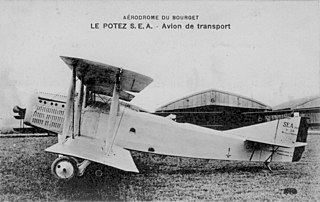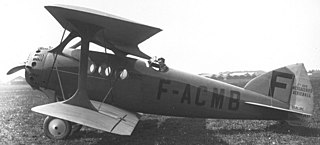
The SEA IV was a French two-seat military aircraft of World War I and the immediate post-war era.

The SPAD S.XIII is a French biplane fighter aircraft of the First World War, developed by Société Pour L'Aviation et ses Dérivés (SPAD) from the earlier and highly successful SPAD S.VII.

The Nieuport 27 was a World War I French sesquiplane fighter aircraft designed by Gustave Delage. The 27 was the last of the line of Nieuport "V-strut" single seat fighters that began with the Nieuport 10 of 1914. Operational examples supplemented the very similar Nieuport 24 and 24bis in operational squadrons in late 1917 and many would also be used as advanced trainers.

The Blériot-SPAD S.34 was a French twin-seat, single-engine biplane flight training aircraft designed in 1920. The side-by-side seating arrangement was unique for its time. 150 aircraft were built, 125 for the French Air Force, who used them until 1936.

The Caudron R.4 was a French World War I twin-engine biplane reconnaissance/artillery cooperation aircraft and the progenitor of a series of successful aircraft that filled a variety of roles with the French Aéronautique Militaire.

The Bleriot-SPAD S.33 was a small French airliner developed soon after World War I. The aircraft was a biplane of conventional configuration whose design owed much to the Blériot company's contemporary fighter designs such as the S.20. Four passengers could be accommodated in an enclosed cabin within the monocoque fuselage, and a fifth passenger could ride in the open cockpit beside the pilot. A great success, the S.33 dominated its field throughout the 1920s, initially on CMA's Paris-London route, and later on continental routes serviced by Franco-Roumaine.

The Caudron R.11, was a French three-seat twin-engine long range escort fighter biplane developed and produced by Caudron during the First World War.

The SPAD S.A was a French two-seat tractor biplane first flown in 1915. It was used by France and Russia in the early stages of the First World War in the fighter and reconnaissance roles. It was a unique aircraft that carried its observer in a nacelle ahead of wing, engine and propeller.

The Hanriot H.43 was a military utility aircraft produced in France in the late 1920s and early 1930s which was primarily used by the Aéronautique Militaire as a trainer. While Hanriot had spent most of the 1920s manufacturing further and further developments of the HD.14 that had flown in 1920, the H.43 was an entirely new design. It was a conventional single-bay biplane with staggered wings of unequal span and a fuselage of fabric-covered metal tube. Accommodation for the pilot and passenger was in tandem, open cockpits and the main units of the fixed, tailskid undercarriage were linked by a cross-axle.

The Letord Let.5 was probably the most numerous of a family of 3-seat reconnaissance bombers, designed and built in France from 1916, originally to an A3 specification from the STAé.
The SPAD S.G1 and SPAD S.G2 were French single seat tractor biplanes of ca 1915/16, following similar arrangements to the SPAD S.A2 family with the propeller and engine buried in the fuselage and a pod suspended in front of the engine. A single SPAD S.A-1 was converted with a small circular section pulpit nacelle mounting a mock-up of a fixed forward-firing machine-gun and smaller wings.

The Henry Farman HF.30 was a two-seat military biplane designed in France around 1915, which became a principal aircraft of the Imperial Russian Air Service during the First World War. Although it was widely used on the Eastern Front, and by the factions and governments that emerged in the subsequent Russian Civil War, it is not well known outside that context: the HF.30 was not adopted by other Allied air forces, and the manufacturers reused the "Farman F.30" designation for the Farman F.30 in 1917.
The Farman F.30A C2 was a two-seat biplane designed as a fighter in France in 1916 and powered by a single, water-cooled radial engine. It showed poor flight characteristics and only one was built, though it was modified twice. It should not be confused with the similarly named Henry Farman HF.30 of 1915, a completely different aircraft which was used in large numbers by the Imperial Russian Air Service.
The Adolphe Bernard AB was a twin-engined French biplane aircraft, built near the end of the First World War. Ten AB 1 BN2 bombers were produced for the Armée de l'Air but did not reach squadron service; post-war, two civil derivatives were considered but only one aircraft was built.
The Salmson 4 AB.2, or SAL-4 AB.2 was a two-seat bomber designed and built in France during the closing stages of World War I.

The de Marçay 2 C1 was a prototype single-seat biplane fighter designed in France and first flown in 1919. It did not go into production.

The Borel-Boccaccio Type 3000, also known as Borel C2, was a two-seat fighter designed and built in France to a 1918 C2 specification.
The SPAD S.XV was a single-seat fighter designed and built in France and offered to fulfil a 1918 C1 specification.
The CANT Z.504 was a prototype reconnaissance biplane flying boat made by CANT in the 1930s.
The IMAM Ro.26, sometimes called the Romeo Ro.26, was a single-engine biplane trainer aircraft produced by the Italian aeronautical company IMAM in the early 1930s. Only one example was built.













